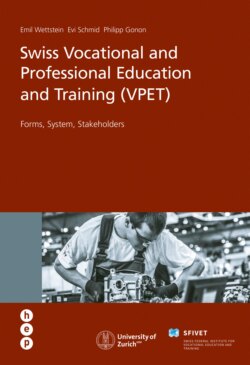Читать книгу Swiss Vocational and Professional Education and Training (VPET) - Philipp Gonon, Emil Wettstein - Страница 14
На сайте Литреса книга снята с продажи.
ОглавлениеPORTRAIT OF CLAUDIA JUON
Claudia Juon, 19,
is attending Frauenfeld Information Technology School and is currently working as a trainee at Bühler AG
clear
When school means practical experience
Getting the commercial Federal Vocational Baccalaureate and the Federal VET Diploma, but twelve weeks of holidays a year – that sounds like education paradise. Claudia Juon is one of the people who lives there.
The 12 August 2013 was a special day in the life of Claudia Juon. For three years, the 19-year-old had attended the Informatikmittelschule (IMS) Frauenfeld (Frauenfeld Information Technology School) and had to deal with classmates and teachers. But now, the fourth year of her training had begun, the traineeship at the company Bühler in Uzwil. Open-plan office, real orders, new reference persons – “I was nervous because I did not know how useful the knowledge from the IT school would be,” recalls Claudia Juon. After two weeks the uncertainty had gone: “I had to continue learning, the programming language alone was different at Bühler.” But the prospective IT technician specialising in applications development had the tools to cope.
Learning contents at the IT school comprise general education subjects and a focus on “Information Technology” and “Economy and Law”. The vocational instruction is geared towards the training plan of the VET programme for the specialisation in applications development and leads to the Federal VET Diploma (EFZ). It is divided into 29 modules. Here, school does not only mean theory, it also means practical experience. Claudia Juon explains: “Around half of the modules were more theoretical, usually chalk and talk. The other half consisted of exercises, group work or projects.” The results of this work were, for example, a website of her own or a reprogrammed calculator. Each module is completed with a competence record consisting of semester grades and a written exam or a project assignment at the end of the module.
Claudia Juon has completed the school-based part of her training. For the Federal VET Diploma she now needs the “individual practical project” (individuelle praktische Arbeit, IPA), while completion of the Federal Vocational Baccalaureate requires an “interdisciplinary project” (interdisziplinäre Projektarbeit). Claudia Juon will tackle both projects during her traineeship, she even has company time available for this, two weeks for each project according to the traineeship contract. This contract also contains information on holidays and the wage, which is generally at the level of a learner in the fourth apprenticeship year. It has to be checked by the IT school and must be approved by the cantonal VET office.
Claudia Juon had to find her traineeship herself, but this was easy for her – “an advantage of being a woman,” she says, smiling. If the search is going slowly, the head of department at the IT school in Frauenfeld, Walter Schnyder, helps out. He says that around half of the traineeship positions are at companies which do not offer dual-track training places. The only requirement for the training is that a programmer has to be part of the team at the company. Until around five years ago, this led to a loss of quality, as Walter Schnyder admits: “At the time, we were glad about every company that offered a traineeship position.” Today, the learners can usually choose between several options.
Claudia Juon has been working at Bühler for a month, supervised by one of the practical trainers who are also responsible for the learners in a dual-track VET programme at the company. At the moment, she is using instructions to install the PCs of external clients, which she then checks and makes ready for delivery. She also helps with the migration of old data to a new version of the department’s project database; she is writing small programs for this, too. And finally she reads the IT books which her specialist supervisor recommends. “For all of this work there is no training plan,” explains Walter Schnyder, “but the companies have to provide evidence that the learners have the opportunity to program during a large part of the traineeship – and are therefore given the foundations for the individual practical project.”
From the perspective of the company Bühler, 42 traineeship weeks is rather short to achieve the training goals, become integrated in the team and become familiar with the company and its culture. Which is why it favours the dual-track training form. Claudia Juon herself would, nevertheless, choose the IT school again. She thinks attending school and subsequently joining the company makes sense and she considers the two of equal value. Laughing, she admits that the twelve weeks of holidays during IT school proved to be no disadvantage.
